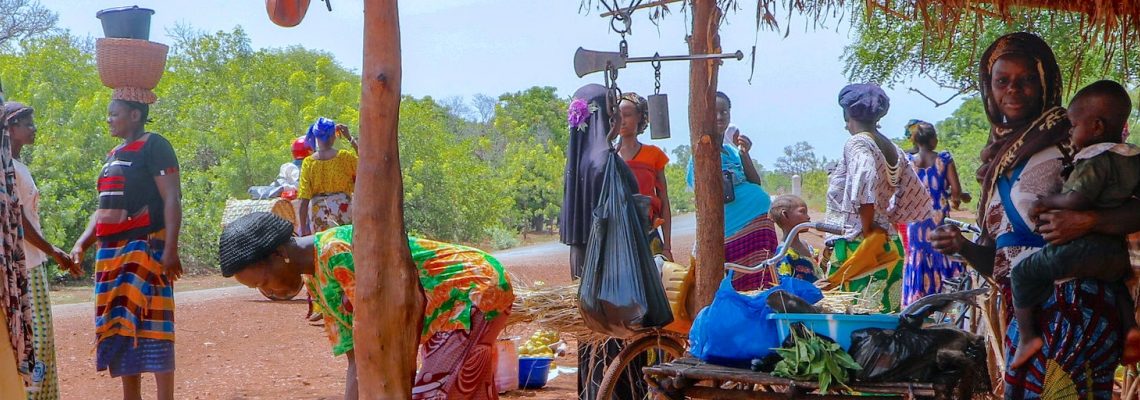Modeling the impacts of new policies on water quality in Burkina Faso

When scientists turn to modeling, it is to investigate possible scenarios that cannot, for one reason or another, be studied directly. You could liken it to peering into a crystal ball, except that nothing is being predicted – rather, potential future scenarios are being explored, depending on varying circumstances.
In Burkina Faso, researchers from TU Wien, working with the International Water Management Institute (IWMI), have turned to modeling to capture how institutions and policies could help halt water pollution, a growing problem in the country. Modeling the impacts of such efforts on water quality can help guide decision-makers and local water committees, institutions tasked with water management, with how best to achieve water quality improvements. The results indicated that fines, incentives and raising awareness could be effective strategies for limiting pollution originating from farms.
Considering human behavior
Socio-hydrological models can be especially useful for producing a range of different future scenarios that might be expected as interactions between people and water evolve. They differ from classic hydrological models by integrating people’s responses to changes in the water system within the model itself. In other words, such models look at how human behavior responds to changes in the water system as well as how the water system responds to human actions.
The central concept is that water and social systems develop together, in a highly interconnected way. For example, as water becomes more polluted, people react – they set up new regulations to reduce pollution. This response in turn leads to changes in the water system, such as improved water quality. Then, water quality improvements drive further reactions from people, in that less polluted, cleaner water may be used for drinking, fishing or recreation, thus increasing human and environmental health, quality of life and perhaps also economic conditions.
Additionally, within this already complex system, changes in the amount of rainfall affect water availability and quality, further driving changes in people’s response. In order to understand this intricate system, a research approach that can simplify its interacting parts is needed, and that’s where socio-hydrology comes into play.
Creating policy experiments
To create a socio-hydrological model that could run policy experiments – exploring how new policies could affect water quality – we, researchers from TU Wien and with support from IWMI, created a conceptual socio-hydrological model of the interactions between people and water quality in southwestern Burkina Faso.
The model was based on available data, reports and existing understanding of water quality management issues in the area. The relationships in the model were then described mathematically, and a range of scenarios on how greater institutional and financial support actually reduces water pollution was produced. A field trip was undertaken to explore if the model and scenarios were valid and accurate. Through interviews with stakeholders, and by observing the system, several changes to the model were identified, and a revised model was developed.
In the end, six scenarios, considering different policy options, were run on the final socio-hydrological model: 1) No management strategies employed; 2) Regulation and enforcement of a 100-meter ‘no cultivation zone’ next to water bodies; 3) Financial incentives and support to respect the 100-meter zone; 4) Financial incentives and support to reduce pollution from sediment and agrochemicals; 5) Financial incentives and support to plant fruit trees in the 100-meter zone; 6) Raising farmers’ awareness of causes of pollution.
Fines, incentives and fruit trees
The results of the model showed that different strategies lead to very different amounts of water pollution from farming. While the baseline scenario showed a continual increase in pollution, the regulation and enforcement as well as the incentive scenario showed that fines and other incentives could be effective in reducing the number of farm plots in the 100-m zone, resulting in a corresponding decrease in pollution.
However, the positive impact would only last for as long as incentives and regulations are being implemented. When support is removed, farmers return to cultivating in the 100-m zone, the model showed. Incentives to plant trees seemed to have a positive impact on water quality, but again, long-term support to farmers to enable them to shift from growing vegetables to fruit trees is also required.
Finally, the model indicates that awareness-raising campaigns could have a positive long-term impact on water quality. This is because the model is designed so that awareness-raising activities increase the willingness and capacity of farmers to implement measures to reduce water pollution, and this leads to a very gradual decrease in cultivation in the 100-meter zone as well as an increase in planting trees and in the adoption of pollution-reduction strategies.
Establishing buy-in for modeled scenarios
It must be emphasized that the model and its scenarios are purely exploratory and not predictive. Therefore, they can tell us what might happen if a particular policy is implemented, but not what will happen. More work, to test assumptions and capture the perspectives of a wide range of stakeholders, would ground the model more firmly in reality.
For the time being, scenarios generated by the model have been introduced to local partners, who have provided feedback. We are using this to explore how the model can be improved to generate scenarios of potential use to decision- and policy-makers. Next steps for extending its use would require further interactive research with local partners and stakeholders, adjusting it to match their realities and meet their needs, and perhaps developing a user-friendly interface so that stakeholders themselves can explore how different policies can drive the system in different ways
In the future, the model could be used to explore the level of subsidies required to achieve land management changes or how different levels of support for local water committees could lead to changes in water quality. In this way, this model could help decision-makers explore how certain actions – fines, incentives or awareness raising – could improve water quality.
Source : CGIAR

